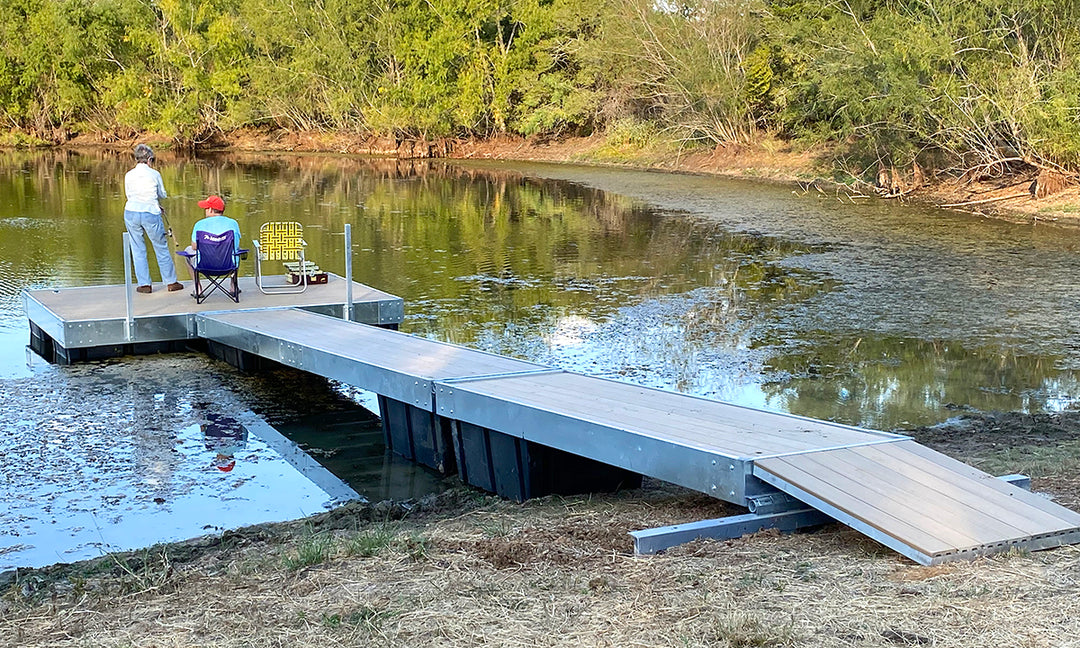Upgrade Your Waterfront With Resilient Floating Docks
Upgrading your beachfront with sturdy floating docks can substantially enhance both performance and visual appeals, giving a versatile option for numerous water tasks. With a range of materials available, including low-maintenance alternatives and conventional timber, picking the right dock can match your individual design and meet useful demands.
Advantages of Floating Docks
Floating docks deal a wide variety of benefits that improve their allure for various maritime applications. One of the primary benefits is their versatility to altering water levels - floating dock company. Unlike standard fixed docks, floating docks fluctuate with the trend, making certain regular availability for watercrafts and watercraft despite ecological problems. This function considerably decreases the risk of damage to vessels, as they stay securely moored even during changes in water depth.
Furthermore, floating docks are simpler to set up and relocate, offering flexibility for momentary or seasonal usage. Their modular layout enables customization to fit certain needs, whether for personal marinas, domestic beachfronts, or industrial applications.
In addition, floating docks create marginal disturbance to the water environment, protecting local communities and lowering the possibility of disintegration. They additionally supply boosted security and security for users, as their buoyant nature provides an extra forgiving surface than stiff frameworks.
Moreover, floating docks can assist in a varied variety of tasks, such as angling, swimming, and leisure boating, making them a beneficial possession for beachfront development. Their convenience and practicality make floating docks a favored selection for a variety of marine tasks.
Picking the Right Materials
Choosing ideal materials for floating docks is essential to their long life, efficiency, and overall efficiency. When selecting products, take into consideration variables such as ecological exposure, maintenance requirements, and architectural stability. Common materials include wood, plastic, light weight aluminum, and composite alternatives, each offering unique benefits and negative aspects.
Timber, while aesthetically pleasing, calls for regular maintenance to prevent rot and decay. Pressure-treated wood can improve durability, however it may still catch water damage gradually. Plastic floats, commonly made from high-density polyethylene, are resistant to deterioration and need minimal maintenance, making them an eye-catching choice for low-maintenance applications.
Light weight aluminum is an additional viable choice, recognized for its stamina and lightweight residential properties. It is resistant to rust and can withstand rough weather, although it may be more costly than various other materials. Compound products combine the ideal features of wood and plastic, offering a low-maintenance and resilient alternative that mimics the look of timber without the associated disadvantages.
Inevitably, the choice of material ought to line up with the meant usage, ecological considerations, and budget plan constraints, making sure a practical and long lasting floating dock that fulfills your certain requirements.
Installation Process Introduction
The effective setup of a floating dock relies upon mindful preparation and execution, ensuring that it runs properly in its designated setting. The primary step entails evaluating website problems, consisting of water depth, shoreline functions, and dominating weather patterns, which will notify the dock layout and anchoring system.
Following the site evaluation, the following stage is to prepare the floating dock components. This includes constructing the structure, securing floats, and connecting any type of essential hardware. It is important to make sure that all links are durable and water-resistant to endure marine conditions.
When the dock is set up, the installment procedure starts with positioning the dock in the water. This can include a crane or other lifting tools, especially for larger structures. Appropriate positioning is crucial for functionality and safety and security.

Maintenance Tips for Longevity
Routine maintenance is crucial for making sure the longevity and ideal performance of a drifting dock. To achieve this, start with routine assessments a minimum of two times a year, concentrating on the stability of the dock's structure, including the flotation protection devices and attaching hardware. Try to find signs of deterioration, wear, or damage, and attend to any concerns quickly to protect against additional damage.
Cleaning up is another essential aspect of upkeep. Get rid of debris, algae, and barnacles from the dock's surface area to avoid slippery problems and maintain aesthetic allure. Use a moderate cleaning agent and a soft brush to prevent harming the dock's products.
Furthermore, ensure that the dock is correctly secured and protected to hold up against seasonal changes in water degrees and weather. Examine the anchoring system for stability and make changes as required.
Enhancing Your Outdoor Visual
To produce an aesthetically enticing exterior look these up space, integrating a floating dock can substantially boost the overall visual of your waterfront property. Floating docks discover this info here are not just functional yet can also work as a striking prime focus that complements the natural environments - floating dock services. Available in various products and layouts, these docks can be personalized to match your building's building style and landscape
The addition of decorative aspects, such as incorporated lights or fashionable barriers, further elevates the dock's visual charm. Take into consideration making use of all-natural timber coatings, which blend effortlessly with the atmosphere, or deciding for modern products like aluminum or composite outdoor decking that offer a smooth, contemporary appearance.
Strategically placing planters or seating locations on or around the dock can create inviting rooms that urge leisure and enjoyment of waterfront views. Furthermore, integrating shades and textures that balance with your landscape will create a cohesive visual throughout your outside location.

Conclusion

Updating your waterside with sturdy floating docks can significantly improve both capability and appearances, offering a functional service for numerous water activities. Unlike standard set docks, floating docks rise and her explanation autumn with the trend, making sure regular ease of access for boats and boat regardless of environmental problems.Selecting proper products for floating docks is essential to their longevity, efficiency, and total effectiveness.When the dock is constructed, the installation process starts with placing the dock in the water.In summary, floating docks deal countless advantages, including versatility to water degree changes and a variety of material choices.